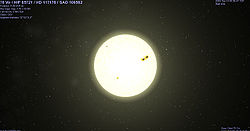70 Virginis
bintang yang terletak di rasi bintang Virgo
70 Virginis (disingkat 70 Vir) adalah bintang kerdil kuning yang berjarak sekitar 59 tahun cahaya[4]di konstelasi Virgo. Bintang ini memiliki cahaya luar biasa cerah untuk jenis spektral dan mungkin baru mulai berkembang ke fase Raksasa merah.
| Data pengamatan Epos J2000.0 Ekuinoks J2000.0 | |
|---|---|
| Rasi bintang | Virgo |
| Asensio rekta | 13j 28m 25.80819d[1] |
| Deklinasi | +13° 46′ 43.6430″[1] |
| Magnitudo tampak (V) | +4.97[2] |
| Ciri-ciri | |
| Kelas spektrum | G4 V-IV[3] |
| Indeks warna U−B | 0.26 |
| Indeks warna B−V | 0,714±0,007[2] |
| Indeks warna V−R | 0.39 |
| Indeks warna R−I | 0.36 |
| Jenis variabel | none |
| Astrometri | |
| Kecepatan radial (Rv) | 4,44±0,13[2] km/s |
| Gerak diri (μ) | RA: −235.562[1] mdb/thn Dek.: −576.283[1] mdb/thn |
| Paralaks (π) | 55,8347±0,1730[4] mdb |
| Jarak | 58,4 ± 0,2 tc (17,91 ± 0,06 pc) |
| Magnitudo mutlak (MV) | +3,70±0,01[5] |
| Detail | |
| Massa | 1.12[6] M☉ |
| Radius | 1,9±0,1[7] R☉ |
| Luminositas | 2,92±0,03[8] L☉ |
| Gravitasi permukaan (log g) | 3.58 |
| Suhu | 5,406±64[8] K |
| Metalisitas [Fe/H] | −0.06[8] |
| Kecepatan rotasi (v sin i) | 4.83[9] km/s |
| Usia | 7.9[8] gigatahun |
| Penamaan lain | |
| Referensi basis data | |
| SIMBAD | data |
| Exoplanet Archive | data |
| ARICNS | data |
| Extrasolar Planets Encyclopaedia | data |
Pada tahun 1996, 70 Virginis diketahui memiliki planet luar surya yang mengorbit mengelilinginya.[10] Ada juga piringan debu dengan suhu maksimum 153 K terletak pada jarak 3,4 AU dari bintang.[11]
Sistem planet
Penemuan planet disekeliling 70 Virginis diumumkan pada 17 Januari 1996 pada pertemuan American Astronomical Society di San Antonio, Texas. Planet itu terdeteksi menggunakan pengukuran kecepatan radial yang diambil dengan teleskop C. Donald Shane di Observatorium Lick.[12][10]
| Anggota (diurut dari bintang) |
Massa | Sumbu semimayor (AU) |
Periode orbit (hari) |
Eksentrisitas | Inklinasi | Jari-jari |
|---|---|---|---|---|---|---|
| b | >7,40±0,02 MJ | 0,481±0,003 | 116,6926±0,0014 | 0,399±0,002 | — | — |
| Debu disc | >3.4 AU | — | — | |||
Referensi
- ^ a b c d Gaia DR2 record for this source
- ^ a b c Anderson, E.; Francis, Ch. (2012), "XHIP: An extended hipparcos compilation", Astronomy Letters, 38 (5): 331, arXiv:1108.4971 , Bibcode:2012AstL...38..331A, doi:10.1134/S1063773712050015.
- ^ Strassmeier, K. G.; Ilyin, I.; Weber, M. (2017). "PEPSI deep spectra. II. Gaia benchmark stars and other M-K standards". arΧiv:1712.06967 [astro-ph.EP].
- ^ a b van Leeuwen, F. (2007). "Validation of the new Hipparcos reduction". Astronomy and Astrophysics. 474 (2): 653–664. arXiv:0708.1752 . Bibcode:2007A&A...474..653V. doi:10.1051/0004-6361:20078357. Vizier catalog entry
- ^ Holmberg; et al. (2009). "HD 117176". Geneva-Copenhagen Survey of Solar neighbourhood III. Diakses tanggal 2010-02-02.
- ^ Shaya, Ed J.; Olling, Rob P. (January 2011), "Very Wide Binaries and Other Comoving Stellar Companions: A Bayesian Analysis of the Hipparcos Catalogue", The Astrophysical Journal Supplement, 192 (1): 2, arXiv:1007.0425 , Bibcode:2011ApJS..192....2S, doi:10.1088/0067-0049/192/1/2
- ^ Gerard T. van Belle & Kaspar von Braun (2009). "Directly Determined Linear Radii and Effective Temperatures of Exoplanet Host Stars". The Astrophysical Journal. 694 (2): 1085–1098. arXiv:0901.1206 . Bibcode:2009ApJ...694.1085V. doi:10.1088/0004-637X/694/2/1085. (web Preprint)
- ^ a b c d Boyajian, Tabetha S.; et al. (July 2013), "Stellar Diameters and Temperatures. III. Main-sequence A, F, G, and K Stars: Additional High-precision Measurements and Empirical Relations", The Astrophysical Journal, 771 (1): 31, arXiv:1306.2974 , Bibcode:2013ApJ...771...40B, doi:10.1088/0004-637X/771/1/40, 40.
- ^ Martínez-Arnáiz, R.; et al. (September 2010), "Chromospheric activity and rotation of FGK stars in the solar vicinity. An estimation of the radial velocity jitter", Astronomy and Astrophysics, 520: A79, arXiv:1002.4391 , Bibcode:2010A&A...520A..79M, doi:10.1051/0004-6361/200913725.
- ^ a b Marcy, Geoffrey W.; Butler, R. Paul (1996). "A Planetary Companion to 70 Virginis". The Astrophysical Journal Letters. 464 (1): L147–L151. Bibcode:1996ApJ...464L.147M. doi:10.1086/310096.
- ^ Trilling, D. E.; et al. (2008). "Debris Disks around Sun-like Stars". The Astrophysical Journal. 674 (2): 1086–1105. arXiv:0710.5498 . Bibcode:2008ApJ...674.1086T. doi:10.1086/525514.
- ^ Sanders, Robert (January 17, 1996). "Discovery of two new planets -- the second and third within the last three months -- proves they aren't rare in our galaxy" (Siaran pers). University of California, Berkeley. Diakses tanggal December 22, 2017.
- ^ Kane, Stephen R.; et al. (2015). "A Comprehensive Characterization of the 70 Virginis Planetary System". The Astrophysical Journal. 806. 60. arXiv:1504.04066 . Bibcode:2015ApJ...806...60K. doi:10.1088/0004-637X/806/1/60.
Sumber
Wikimedia Commons memiliki media mengenai 70 Virginis.
